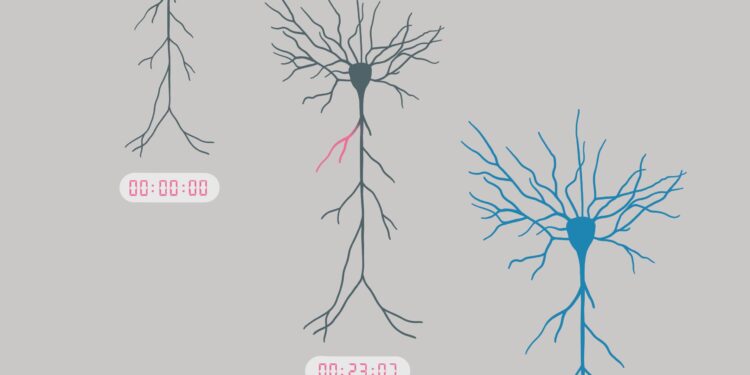Extended duration: Scientists at the Max Planck Neuroscience Institute in Florida have identified a key step in how neurons encode information on time scales that correspond to learning. Credit: Helena Pinheiro
New research from the Max Planck Florida Institute for Neuroscience published this week in Nature identified a key step in how neurons encode information on time scales that correspond to learning.
Learning takes from a few seconds to a few minutes. However, the best-understood mechanisms of how the brain encodes information occur at speeds closer to neuronal activity – about 1,000 times faster. These mechanisms, known as Hebbian plasticity, suggest that if two connected neurons are both active within one hundredth of a second, then the connection between the two neurons is strengthened.
In this way, the information arriving at the connected neurons in this short time can be linked. However, during behavior, information that must be encoded together is often separated by seconds to minutes. How, then, can neurons integrate information over time scales relevant to learning?
A new learning model
Recently, a new neural model of information coding called behavioral time-scale synaptic plasticity (BTSP) resolved this discrepancy by demonstrating that neurons can integrate information over a period of seconds, a time scale consistent with the behavior. Indeed, during behaviors such as navigation, neurons encode specific locations via BTSP. However, the molecular mechanisms by which neurons implement BTSP were unknown.
This week, a research team led by Dr Anant Jain, Dr Yoshihisa Nakahata and Scientific Director Dr Ryohei Yasuda identified key aspects of how BTSP works in neurons, reporting on their years of study on this model critique of plasticity.
Dr. Yasuda describes the team’s motivation for the project: “Understanding the precise molecules and mechanisms that neurons use to encode information is essential to understanding brain function and health. Research in this area has primarily focused on traditional plasticity models, which may be less relevant. to learning during the experience. It is essential to explore the molecular mechanisms underlying novel models of plasticity, such as BTSP.
The team’s first hurdle was modeling the BTSP in isolated brain tissue, where they could precisely measure the resulting neuronal changes. The researchers were able to trigger BTSP by inputs separated by approximately 1 second, confirming the prolonged integration time of information storage. The team also discovered that BTSP occurs at single synapses, a property critical to the specificity of information encoding.
By combining electrophysiological measurements of neuronal activity with specialized microscopy and biosensors, the team was able to visualize the real-time molecular changes occurring during BTSP to determine their role.
CaMKII: same player, different role
The research team focused on a molecule called CaMKII, well known for its essential role in many types of neuron plasticity.
“We hypothesized that CaMKII would be critical for BTSP. This molecule is activated at synapses and can remain active for several seconds. It seemed to be the ideal candidate to play a key role in extending the time window integration of information in neurons”, explains Dr. Jaïn. “Well, it turns out we were right: CaMKII was essential for BTSP, but we were completely wrong about its role.”
When the research team disrupted the functioning of CaMKII, the BTSP was disrupted. Wanting to visualize CaMKII activity in neurons during the BTSP process, the group optimized a biosensor to signal when CAMKII was active. Using this newly optimized sensor, with almost twice the sensitivity of previous tools, scientists were able to measure CAMKII activity during BTSP. However, they did not find what they expected.
Contrary to their hypothesis, they found no detectable activation of CaMKII upon BTSP induction. Instead, delayed, stochastic activation of CaMKII occurred tens of seconds after BTSP initiation. Furthermore, while plasticity occurred at a specific synapse, CaMKII was active in a much larger area of the neuron.
The research revealed that CaMKII is an instructive signal for BTSP but does not define synapse specificity of plasticity. This suggests a broad time window for synaptic plasticity and a new model of how instructive, synapse-specific signals can integrate over tens of seconds.
“This is a paradigm shift in our view of CaMKII function and in our understanding of plasticity mechanisms. CaMKII activity in the dendrite reveals that it does not define the synaptic specificity of plasticity, but that it is rather involved in dendritic information processing. Our results have opened up “There are still many other questions to explore, notably what defines the specificity of information coding at single synapses. the activation time of CAMKII,” explains Dr. Jain.
“These surprising results highlight the importance of relevant behavioral patterns of information encoding in the brain to achieve our ultimate goal of linking molecular activity to memory formation and preventing neurological disorders involving brain dysfunction. “learning and memory.”
More information:
Ryohei Yasuda, Dendritic, delayed and stochastic activation of CaMKII in behavioral plasticity on a temporal scale, Nature (2024). DOI: 10.1038/s41586-024-08021-8. www.nature.com/articles/s41586-024-08021-8
Provided by the Florida Max Planck Institute for Neuroscience
Quote: Extended synchronization: How neurons encode information on time scales that correspond to learning (October 9, 2024) retrieved October 9, 2024 from
This document is subject to copyright. Except for fair use for private study or research purposes, no part may be reproduced without written permission. The content is provided for informational purposes only.



